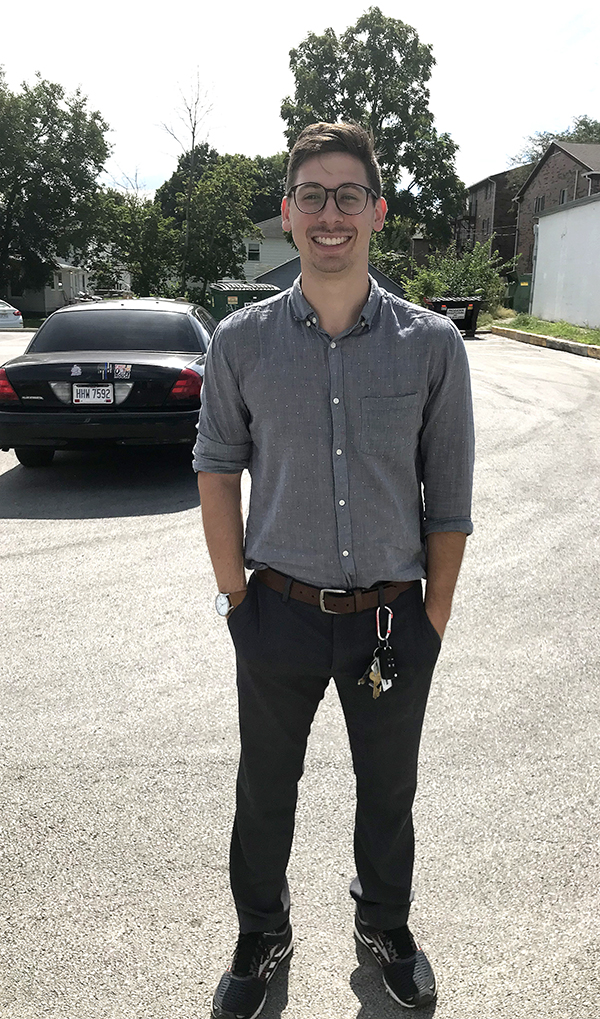Changing Goals
Young stroke patient’s recovery inspires a new academic path
By Laurie B. Davis

But when O’Connor got off the dizzying ride, he noticed his right hand felt numb. About an hour or so later, he was at an urgent care clinic. “I don’t know how I got from the lobby to the care room,” says O’Connor. His stepmom had driven him there, and his father arrived shortly after. An ambulance was called, and when the EMTs asked O’Connor his name, he answered “seven.”
The 20-year-old was transported to Toledo Hospital and once at the emergency room, O’Connor’s mom arrived. He tried to ask her a question and he vomited. O’Connor was presenting symptoms of brain damage and a CAT scan was ordered. That day, he was admitted as a stroke patient.
O’Connor is glad he stopped by his father and stepmom’s home near Wildwood instead of going to his apartment shortly after his symptoms started. “Thinking about it now in retrospect, it probably was a life-saving decision,” says O’Connor. He was able to describe his symptoms to his stepmom, talk to his sister, a nurse, who suggested urgent care if his symptoms worsened, and was taken to immediate care as it became clear something was seriously wrong.
Youth on His Side
The CAT scan and an angiogram revealed a bleed in his brain, which was causing swelling. The type of stroke that had occurred, an arteriovenous malformation, targets younger people more often than other types of strokes do. But his youth also may have played a role in O’Connor’s quick recovery. The headache that usually accompanies this type of brain damage came later and was the worst pain O’Connor had ever had, he says. The doctors needed to get the swelling and blood pressure down.
He was hospitalized for 10 days before going to inpatient rehabilitation at Flower Hospital for another 30 days.
Numbness and paralysis on his right side persisted for O’Connor as did aphasia, an impairment of his speech. By the third day in the hospital, the caregivers began doing therapy. They made him sit up and do counting and sequencing tasks. They tried to trigger old memories, things that should have been simple for him to remember. “I was really scared I wasn’t going to be able to talk again,” says O’Connor. “No one really told me I was going to get better during the first days.” Most of the conversations were between the doctors and his parents, “and you’re so out of it,” he adds.
His mom told him he was going to get better and that gave him some hope.
O’Connor says he made a lot of progress during inpatient rehab. “When I came in, I couldn’t say my name. It was so frustrating. I could say some stuff. Voluntary speech was easier to speak than answering their questions. I could say a few words, or I’d say the wrong word. By the time I left, I could have regular conversations.” O’Connor attributes his quick recovery to the reduced brain swelling but also to his speech therapist, Melinda Howe, who, he says, “was very skilled and knew what she was doing.”
O’Connor believes he challenged Howe. “She had to keep changing goals because of my quick progress; I guess I kept her on her toes.” She was challenged to try new techniques. “She gave me a good home program,” which he did with his stepmom, who is a teacher. “It’s the drill aspect of recovery that works. It’s what you do outside of the therapy that really affects the recovery. You’re only doing an hour of therapy during the day.”
Shifting Gears
O’Connor talked with his parents about how he might switch his business major to do something related to stroke survivors. “I wanted to help other people going through this experience. The impact the speech therapy had on my life and the impact of the therapist was very cool for me,” says O’Connor. At first, he wanted to pursue psychology and possibly counsel young stroke patients. “But that’s a very small demographic,” he decided.
UT’s business school advisers understood O’Connor’s desire to change majors and informed him that all he needed was one more course to claim a minor in business, which he did. He began his program in speech language pathology at UT when he returned to school in January 2016, and graduated in May 2018. Now enrolled in Bowling Green State University’s Communication Sciences and Disorders and working on his master’s degree, O’Connor says he’s well-prepared for his next round of clinicals.
At UT, O’Connor was able to work in a clinic with a real person. “I think it’s very rare to have undergrads do therapy, and there are only a few places in Ohio that has undergrads do actual therapy.” O’Connor says a lot of his cohorts at BGSU have never been in a clinical therapy setting. “They’re nervous of course to be working with an actual human, which is scary when you’re so young and haven’t ever done it. I feel so well-prepared. That’s a great thing that UT offers,” says O’Connor.
Healing and Adapting
Over the past three years, O’Connor’s speech has fully recovered. Physical therapy has helped him regain much of the feeling on his right side, but he does have hemiparesis, weakness on the right side of his body with reduced muscular strength. He also has difficulty with fine motor skills using his right hand. “The theory is that what was affected first is the hardest to heal and is the most damaged.” Fine motor movements such as typing have been affected, but O’Connor says he adjusts and changes the way he functions. “That’s one thing I want to tell stroke patients: you might not be able to do stuff you used to do the same way, and a lot of people just give up, but you can find other ways to do it.
“When people have strokes or brain injuries, their emotions are very much affected,” says O’Connor. Stroke patients can experience chemical abnormalities in the brain and brain wave imbalance between brain hemispheres, which can trigger anxiety and depression. He did neurofeedback training to help normalize his brainwave function, but it took some time before he would use drugs designed for anxiety and depressed moods.
The stigma that still exists about mental disorders kept O’Connor from using these medications, he says. “For the first year or so, I was adamant that I didn’t want to be on any antidepressants or anti-anxiety medications because this makes sense why I’m sad, this is what happened, I don’t need drugs to fix that. This is what it is.” But when he eventually tried an SSRI, a selective serotonin reuptake inhibitor, it was a new world. “That really turned it around for me. The mood is just alleviated. It got me out of the darker thoughts. I was very impressed at how helpful that could be.”
One of O’Connor’s biggest concerns during his recovery was that the stroke had damaged his intellect and ability to academically excel. But the aphasia he learned, doesn’t affect cognition, just the part of the brain that controls speech. “I was very self-conscious and nervous about it because I had a 3.98 [GPA] before the stroke. But when he graduated from UT with a 3.95 this past May in his newfound major, O’Connor was relieved. “It was cool to see that it wasn’t affected.”






